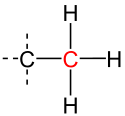Tertiäres Kohlenstoffatom
| Tertiäres Kohlenstoffatom |
|---|
 |
| Strukturformel von Isobutan (das tertiäre Kohlenstoffatom ist rot markiert) |
Ein tertiäres Kohlenstoffatom ist ein Kohlenstoffatom, welches an drei weitere Kohlenstoffatome gebunden ist. Aus diesem Grund sind tertiäre Kohlenstoffatome nur in Kohlenwasserstoffen mit mindestens vier Kohlenstoffatomen zu finden. Tertiäre Kohlenstoffatome können beispielsweise in verzweigten Alkanen, nicht aber in linearen Alkanen, auftreten.[1]
| Vergleich von tertiären mit primären, sekundären und quartären Kohlenstoffatomen (rot) | ||||
| Primäres Kohlenstoffatom | Sekundäres Kohlenstoffatom | Tertiäres Kohlenstoffatom | Quartäres Kohlenstoffatom | |
| Allgemeine Struktur (R = Organyl-Rest) |  |  |  |  |
| Auszug aus Strukturformel |  |  |  |  |
Siehe auch
Einzelnachweise
- ↑ Hans Peter Latscha, Uli Kazmaier, Helmut Alfons Klein: Organische Chemie: Chemie-Basiswissen II. 7. Auflage. Springer Spektrum, Berlin 2016, ISBN 978-3-662-46180-8, S. 40.
Auf dieser Seite verwendete Medien
Primäres Kohlenstoffatom (Allgemeine Struktur)
Strukturformel von Isobutan, das tertiäre Kohlenstoffatom ist rot markiert
Sekundäres Kohlenstoffatom (Auschnitt aus Struktuformel)
Quartäres Kohlenstoffatom (Allgemeine Struktur)
Tertiäres Kohlenstoffatom (Allgemeine Struktur)
Tertiäres Kohlenstoffatom (Auschnitt aus Struktuformel)
Quartäres Kohlenstoffatom (Auschnitt aus Struktuformel)
Primäres Kohlenstoffatom (Auschnitt aus Struktuformel)








